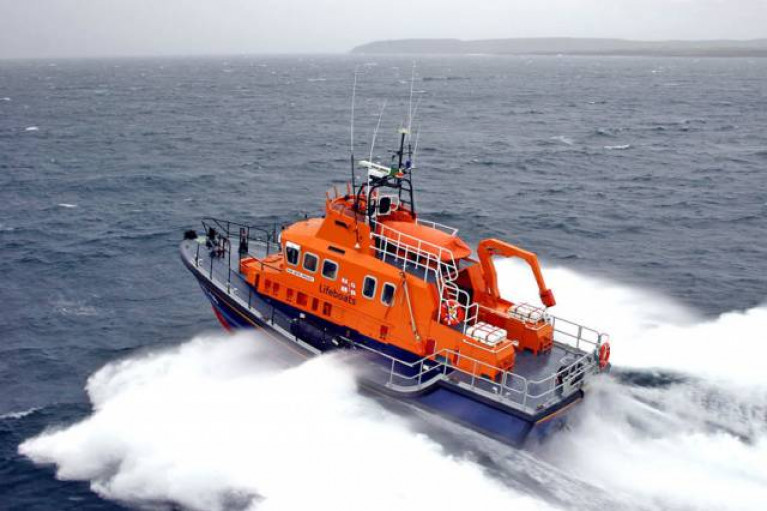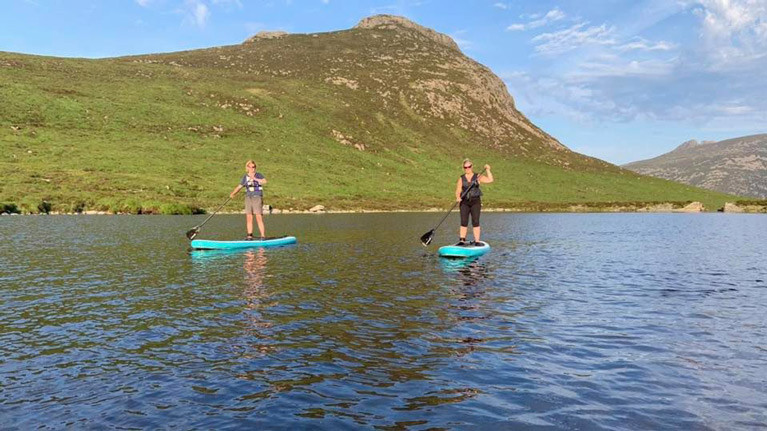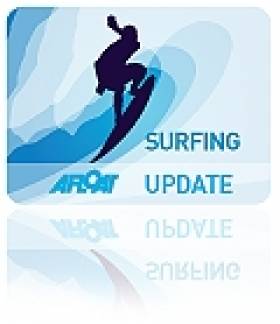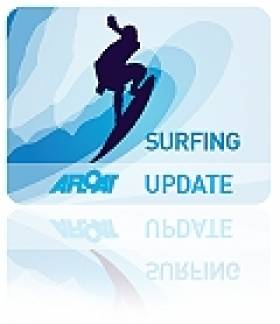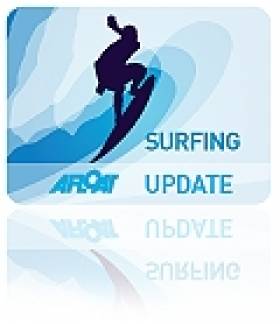Displaying items by tag: paddleboarding
Ulster Rugby Team Goes Paddleboarding at Bangor Harbour
SUFTUM which means Stand Up for the Ulster Men is the rallying cry for the Ulster Rugby team and is of course part of the Ravenhill Roar heard most enthusiastically reverberating around the Kingspan Stadium at Ravenhill when Ulster play at home. But on Monday (24th) Standing Up meant most of the Squad out in Bangor Harbour on (and in) the wintery cold water on Paddleboards, under the watchful eye of Iain McCarthy of Suphub NI. Somewhat different from playing in the 34 -31 victory over Clermont Auvergne in the Heineken Champions Cup on the Saturday before.
Iain McCarthy who runs SuphubNI says one of the objectives was to deliver team building. And last week he had an enquiry from Ulster Rugby about accommodating the whole 45 strong squad and numerous staff. Now when Ian set up the school, he had six boards and as he says “ I always knew this would be a great way to bring teams and groups of people together. Water is a great leveller and as a school that has gone out of its way to source everything from boards, paddles, wetsuits, buoyancy aids etc for every size, shape and style of person possible to make the sport as accessible as possible, I can tell you even I was questioning if we had enough kit to accommodate this group of lads and lasses. Whilst this was a great test of that ambition, we passed”.
 Ulster Rugby paddleboarders (l to r) Marty Moore, Alan O'Connor, Jack McGrath and Billy Burns
Ulster Rugby paddleboarders (l to r) Marty Moore, Alan O'Connor, Jack McGrath and Billy Burns
As it turned out Iain managed to get 30 afloat and others including the injured watched from the pier. One of the squad called the break from usual training ‘Enforced fun’! It was the first time the Mega SUP which is a large board designed to take 8 people, looked small. And when a 6ft 7in player approached and said he tried paddleboarding before and couldn’t nail standing, he was instantly and confidently pointed to a board that gave him the support and stability he needs, and off he goes and flies”.
Once they’d all been around the coast to Brompton, two miles west of Bangor, and back, they had a ‘muck around’ and a swim, and hot chocolate and scone from a nearby deli rounded the session off nicely.
Iain says “All sport means a lot to us. Many of the team have played various sports to a high level and our ambitions are to raise the standard and accessibility of Paddleboarding in Northern Ireland.
Good luck to Ulster at home to Welsh side Scarlets on Friday 28th at the Kingspan Stadium.
All Wales Boat Show Moves Under Cover as Carol Vorderman’s Paddleboarding Boosts Marine Tourism
The booming watersports and marine industry in the UK will be riding the crest of a wave next year - helped by celebrities like Carol Vorderman taking up paddleboarding.
Organisers of the 2022 All Wales Boat and Leisure Show are expecting a bumper crowd of 6,000 visitors to attend the event which they say can help kick start the recovery following the slump caused by the Covid-19.
The show is moving undercover to Venue Cymru in Llandudno and will take place earlier in the year than usual, on the weekend of February 5 and 6.
Davina Carey-Evans, the managing director of event organisers Sbarc, said: “This will be the biggest celebration of watersports in Wales and is a must-visit event for boat owners and watersport lovers.
“The marine sector is growing faster in Wales than any other part of the UK and watersports generate an annual tourism spend of more than £300 million.
“Much of that is generated by boating enthusiasts and it’s estimated that 25,000 trailer boats of all sizes are pulled along the A55 every year.
“But increasingly we are seeing a huge increase in other watersports, from the success of surfing at Adventure Parc Snowdonia to canoeing, kayaking, windsurfing and now paddleboarding.
“The show will reflect that rich diversity of sports that are enjoyed not just along our coastline and in the seven marinas we have along the North Wales coast but on our rivers, canals and lakes.
“Wherever you are in Wales you’re never far from the water and the show will reflect that and the many ways you can enjoy yourself on that water.
“North Wales is also home to some of the very best outdoor facilities from stunning coastlines to inland lakes and rugged, challenging mountains.
The All Wales Boat and Leisure Show will be in its eighth year, having previously been held outdoors in Conwy, Pwllheli and on Anglesey and is timed to catch watersports enthusiasts before the season gets properly under way.
There will be a host of boating and watersport activity providers at the event and the chance for visitors to get their hands on everything from boats to surfboards with exhibitors including Training Centres, Sales and Repair, Marinas, Chandlery, Leisure Parks, as well as have a go sessions and workshops.
There is expected to be plenty of interest in the growth sports such as windsurfing and particularly stand-up paddleboarding, Wales’s lockdown boom sport of the summer with numbers up by 70 per cent to 180,000 this year, according to a former international yachtsman and watersports expert.
Alistair Dickson, who has won sailing gold medals at World, European and British Championships, is now chief executive of Canoe Wales - and a fan of the breakout sport of 2021.
Paddleboarding has attracted its share of celebrity devotees – ex-Countdown queen Carol Vorderman has been pictured trying it out in a figure-hugging wetsuit on a West Wales holiday this summer - while Torquay lifeguard Brendon Prince set a record for paddleboarding from Land’s End to John O’Groats.
The show will have a section devoted to stand-up paddleboarding and Alistair, from Llandudno, a former Performance Director at the Royal Yachting Association, takes to the waters of the Menai Straits with friends every week.
He said: “Paddleboarding is so accessible – you can fit one in or on the car and you can get started easily because it is relatively simple to master.
“It’s a big growth area – people have been cooped up for 18 months and they are looking to get out and about and we’re also seeing a big increase in numbers canoeing and kayaking.”
Anglesey motorboat specialist Dulas Boats, based at Dinas, near Moelfre, stocked paddleboards for the first time this year and have seen them almost sell out.
Alwyn Rowlands, who started the business with his father almost 50 years ago, said: “They’ve gone very well – they’re a really good way to get onto the water.
“Kayaks used to be the thing and they’re great but they’re heavy. A paddleboard you can carry in a rucksack or a bag and just pump it up and off you go.
“It’s important that you have the right safety gear of course but they’re a great introduction to watersports and they’re relatively cheap. It’s great to see people taking it up.”
Davina Carey-Evans added: “There is something out there for everyone and we are aiming to showcase that at the show which has been moved to a new date, in February, and a new venue, Venue Cymru, in Llandudno.
“We’ve weatherproofed it by holding it indoors at Venue Cymru but the sea is just outside our doors which makes it an ideal home for the show which aims to connect the boating industry and services from across the UK with water sports enthusiasts and anyone who has a passion for the great outdoors.
“It’s family-friendly and will feature a huge range of exhibitors, events and activities where you can have a go too.”
Air Sea Search Underway for Two Missing Paddleboarders in Galway Bay
An extensive air and sea search is underway in Galway Bay after two young women who set out on stand-up paddleboards from Furbo last evening failed to return to shore.
The two women are aged 17 and 23 and from Galway, are believed to have left Furbo beach at around 8 pm on Wednesday.
The alarm was raised at 9 pm when they had not returned.
The women were wearing buoyancy aids, but not wetsuits. Sea conditions were calm but with an offshore north-westerly breeze.
The RNLI Aran island and Galway lifeboats, the Irish Coast Guard’s Shannon and Sligo-based helicopters and Doolin and Costello Coast Guards have been searching throughout the night for the two women, while local volunteers have also been combing the coastline.
Galway RNLI operations manager Mike Swan said that lifeboat crews combed the sea area throughout the night.
“The search area had focused on the inner Galway bay area and had extended west to Black Head,” he said.
Salthill Garda station is coordinating the search, working with the Irish Coast Guard and RNLI, and a meeting took place in Spiddal this morning.
The Marine Institute based in Oranmore has launched its rigid inflatable, along with a number of local craft, and the institute’s ocean sciences staff are also working on the tide and current modelling to assist the search crews.
Residents living close to the coast from Barna west to Spiddal have been asked to check the shoreline near their homes.
Update 11 am Thursday, August 13
Statement from the Irish Coast Guard on search operation for two missing females
The Irish Coast Guard Coordination centre at Valentia are currently coordinating an extensive search of Galway Bay after two females aged 17 and 23 who were paddleboarding at the time were reported overdue last night at 10:05 pm just off Furbough, Co. Galway. All available Air and Marine Rescue assets are currently being utilised in the search and the Coast Guard are liaising with An Garda Siochana at Salthill in an effort to locate the two missing females. Any sightings or information should be reported to the Coast Guard at MRSC Valentia on 112 or 999.
Paddleboarding in the Mountains
Stand up Paddleboarding in the mountains? Lough Shannagh (or the Lough of the Fox), is a corrie lake on the southern side of the Mournes in County Down and lies at 390m at the foot of Carn Mountain. It is the largest body of water in that range and rests on a high plateau. It can be reached by an old drover’s road.
It is certainly a unique spot for Stand Up Paddleboarding but that is what Wild Mountain Adventures are offering on Sunday 9th August. Petra Armstrong and her friends Cathy Reavy and Hannah McKnight are all qualified mountain leaders and set up Wild Mountian Adventures NI to give others the experience of all the kinds of adventures that they do regular basis. Among those ventures are the North Coast Challenge and From Couch to Donard (the highest mountain in the Mournes) 10-week fitness plan.
The price includes paddleboard, buoyancy aid a complimentary photo and video footage. You do have to be able to walk the rough track up to the Lough and for those not familiar with the mountains, there is the option of a package including a guided hike to Lough Shannagh
More info here
Stand Up Paddleboarders Complete 46km Galway Voyage
#sups – Three Stand Up Paddleboarders from Rusheen Bay Windusrfing School made the 46.5km journey from Kilronan Pier on Inis Mor to Blackrock in Salthill, Galway last Saturday.
A distance normally associated with a motorised or sailing craft, the team comprising of Daniel King, Maurice Owens and Danny Mulryan made the trip on Stand Up Paddleboards (SUPs).
Setting off from Aran at 9am last Saturday morning, they completed the voyage in just over 8 hours. It is estimated that each of them completed 15000 paddle strokes and completed the longest trip on a SUP in the country to date. Commenting on the adventure, Danny Mulryan said "It was a very enjoyable trip and a great way to familiarise ourselves a little more with the coastline. We were all glad to see the diving tower on the horizon".
The team who are in the final stages of launching 'Paddle on the Prom' are looking forward to planning the next adventure.
Irish 'Happy to Be a Part' of First SUP and Paddleboard Worlds
#SURFING - Team Australia proved that when it comes to watersports, they're a step above most of the competition at the inaugural ISA World Stand-Up Paddle (SUP) and Paddleboard Championships in Lima, Peru recently.
The paddleboarding duo of Brad Gaul and Jordan Mercer each won three gold medals, along with the team gold medal and the perpetual Club Waikiki Trophy, which will be awarded to the overall team champion every year.
But for every powerhouse team like Australia, the USA and South Africa, there were teams like Ireland who arrived at the world championships to represent themselves well, but also to be able to say they were there for the beginning of something big.
"The event was just amazing, such a positive vibe amongst all the competitors, everybody that we met from local organizers to everyone at our hotel or the drivers," said Finn Mullen, who competed along with teammates Dave Owens, Paul Byrne, Ed O'Farrell, Keith Gorman and Jane Downes.
"They were all so stoked to have the contest and see us all here," Mullen added "and there was like this amazingly friendly vibe in the water, because really they were being super gracious to us, giving us the break for the entire week, and they couldn't be more accommodating and I couldn't me more happy that I was able to be a part of it."
Irish Six in Peru for SUP and Paddleboard Worlds
#SURFING - A six-strong Irish team is in Peru to compete in the inaugural World Stand-Up Paddle and Paddleboarding Championships, which commence today (19 February).
The surfers have travelled at their own expense to the Peruvian capital Lima to take part in the International Surfing Association-sanctioned event, where they will contest against paddleboarders from 19 other countries.
“It is the first of its kind and we wouldn’t want to miss out," team member Paul Byrne told TheScore.ie. "The fact that it has been recognised enough to hold an international competition means stand-up padding (SUP) is here to stay.”
Dubliner Byrne first got involved in SUP in Australia, and found on his return to Ireland that he and his friends didn't need to seek out the popular surf out west to keep up with the sport - the swell produced by ferries in Dublin Port is just what they needed (see video of Dave Owens above).
Byrne joins Owens, Finn Mullen, Ed O'Farrell, Keith Gorman and Jane Downes in South America for the World Championships, which run till 25 February.
“We been competing in Europe," he says, "but it is sure to be tough against surfers who are sponsored to do it for a living.”


























